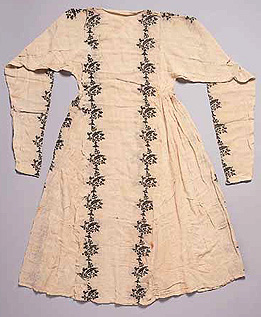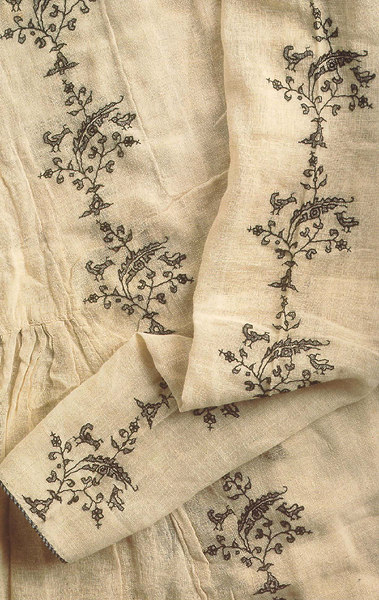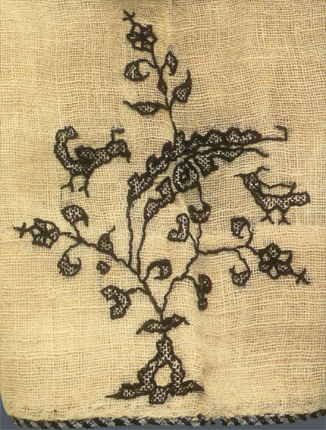Dar Urtatim Presents:
14th Century Persian Embroidered Cotton Pīrāhan
pirahanThe text for this page and the two top pictures are from Sara Kuehn Islamic Arts www.sarakuehn.com
The bottom two pictures came from the Cloud Band website
Everything in this page is copyright Sara Kuehn except my comments.
I have put them here as a reference for historical costumers, since they are no longer accessible on Sara Kuehn's site.
 |
 |
|
The dress is constructed of rectangular and triangular segments, the latter set into the sides to give the garment volume. The sleeves are attached at the shoulder, and become narrower towards the wrist. The waist is accentuated by pleats underneath the sleeves. A flap covers the area of the collar which is still in unopened condition. Each segment is decorated with a sequence of motifs com prising a flowering tree with a root out of which grow leafy branches, flanked on either side by a long-tailed bird perched on a branch with its wings outstretched. Height 130 cm (51 ins.), width 219 cm (86-1/4 ins.) Eastern Iranian world
Radiocarbon dating undertaken by the Institute of Particle Physics (ETH), Zurich, Switzerland: Ground fabric cotton, balanced plain weave, gauzy Warp Z-spun, 16/cm, 0.1-0.5 mm diameter, tight twist Weft Z-spun, 15/cm, 0.1-0.5 mm diameter, tight twist Decoration chain stitch and running stitch embroidery, brocading
Comparable item |
A history of costume in the Eastern Iranian World remains to be written. Pieces such as those presented here, catalogue numbers 10 and 11, can provide us with further evidence regarding the types of costume used, their construction and decoration. Our knowledge of mediaeval Islamic costume is uneven. Egyptian costume of the Coptic and Early Islamic periods, for example, is an area which has attracted much research, partly due to the fact that more textile material has survived there in burials due to the dry climate. Well known are the numerous Coptic tunics in various museum collections. From the Islamic period, perhaps one of the most significant garments to have survived is a child's shirt in the Textile Museum Washington, inv. no. 73.444, inscribed with an embroidered inscription in Kufic in the name of the Abbasid caliph al-Muqtadir (295-320 AH/908-932 AD).1 Another is a large adult's shirt in the Ashmolean Museum, Oxford, carbon-dated to the early 11th century, decorated with large brocaded epigraphic bands. There are, additionally, quite detailed accounts of the contents of the Fatimid treasury, and copious depictions of clothing on Fatimid ceramics have survived. In the Iranian East, the picture is different. Perhaps the earliest garment fragment from Iran is a Parthian child's wool jacket fragment lined with cotton, dated to the 1st century BC, found at Shahr-i Qumis during excavations by the Metropolitan Museum of Art.2 The Sasanian period is well documented because of the depictions of royal clothing on the stone reliefs at Taq-i Bustan. Evidence for the early Islamic period, however, is largely literary and pictorial. |
A well-known wall painting depicting a mounted falconer dressed in a long decorated cloak, was found during the excavations of the early Islamic city of Nishapur.3 However, the existing material textile evidence from archaeological excavation is mainly frag mentary, such as the finds of fragmentary, such as the finds of Buyid silks at Rayy in the 1930s. As the garments presented here come from the Eastern Iranian world they can provide an idea of the continuity of dress which has existed there since antiquity. The gauzy embroidered cotton kamis, surviving almost complete and dated to the 13th to 14th century, largely conforms in shape to the overcoats worn at the Mughal and Safavid courts, which too were long-sleeved, tight over the chest, but voluminous over the legs. They survive in luxurious woven silks, but on Mughal miniatures they are also represented as transparent gauzy fabrics.4 To some extent, it seems, these originate in the Central Asian nomadic tradition, from which both the Safavids and Mughals claim descent.5 The present dresses can thus be seen as mediaeval examples of this long-lived tradition, offering valuable insight into the evolution of the costume of the Eastern Iranian world.
|
 |
 |
|
My notes:
| |
|
|